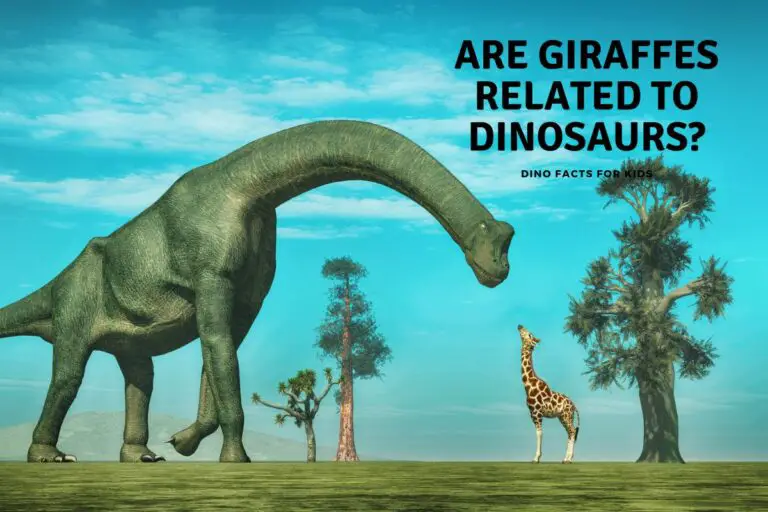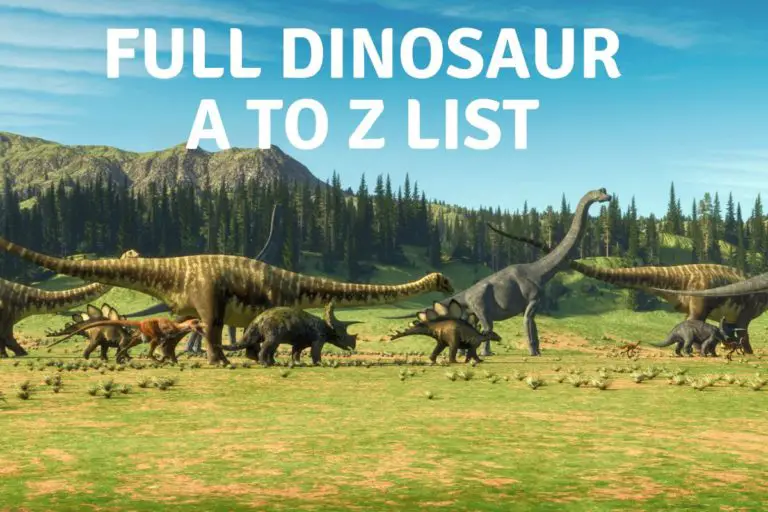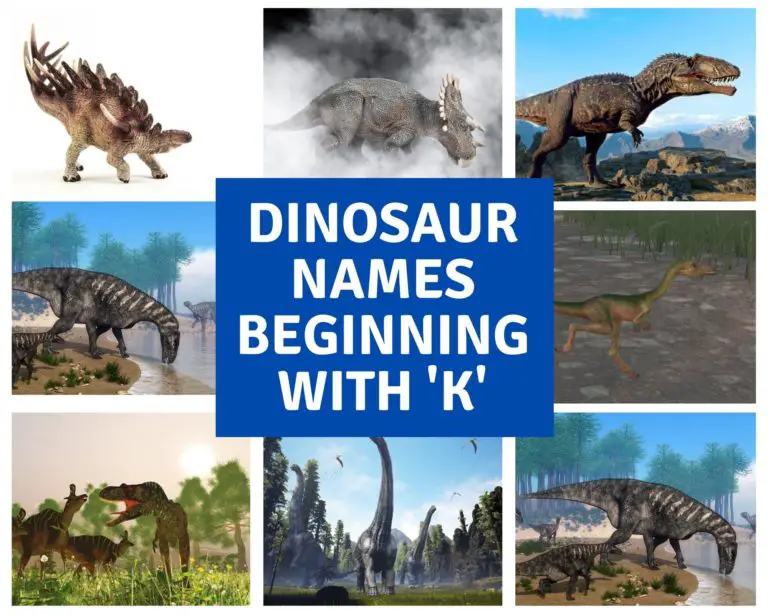Are Megalodon Alive Today?
Megalodon although the largest predatory shark to exist has been little known until it received the Hollywood treatment, with both movies like the Meg and Documentaries suggesting that the Megalodon might well still live in the depths of our oceans. Much like the great White Shark and the movie Jaws there was a lot correct about these depictions and a lot incorrect. They have led the to the common question are there megalodons alive today? We take a look in the article below.
Megalodon are not alive today. They went extinct over 2 million years ago due to ocean cooling and the reduction and migration of their prey species. Documentaries and images that show current or recent evidence of Megalodons existence have been created with entertainment and not scientific accuracy in mind.
We recently published an article on the size comparisons between a Blue whale and a Megalodon, which you can read on the link above, which addressed the fact that Megalodon despite rumors and conspiracies did not in fact live at the same time with Blue whales, never mind at the time time as humans, they were not alive and the two species would never have met.
We take a look at the reasons why this is the case, and why Megalodons are not alive today in more detail below.
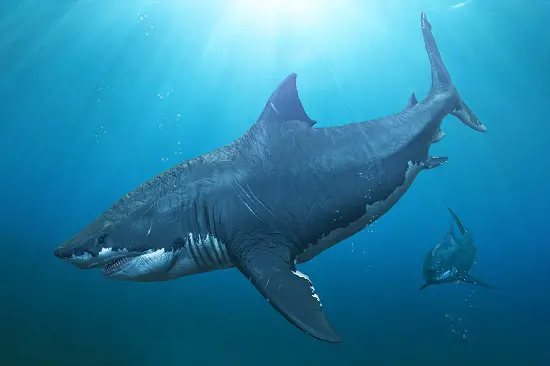
Is there ANY evidence that Megalodon is alive today
There is certainly no scientific evidence that megalodon is still alive today. Megalodon is classified as an extinct species, and there is no credible evidence to suggest that the shark has survived to the present day. There are however plenty of less than credible evidence that relies on both imagination, fears, hearsay, and sensationalism. We will try to address all of these points below.
There have been various reports of alleged megalodon sightings over the years, but most of these reports have not been supported by scientific evidence and are considered to be hoaxes or cases of mistaken identity. A case in point is that there have also been many reported sightings of both the Loch Ness Monster and Aliens and, admittedly as of yet, there is also no evidence for the existence of these.
For example, some alleged megalodon sightings or being alive may be cases of people seeing large sharks that are misidentified as megalodon, like basking sharks or whale sharks, see below for details on their size comparisons. while others may be based on legends or myths that have been passed down through the years.
Why Could Megalodon Not Survive today?
There are several reasons why megalodon be alive today, each one is enough to prevent its survival, and together make it a certainty, even in the vastness of the oceans today.
- First and foremost, megalodon lived in a completely different time period and environment than the one we have today. The Earth’s climate and oceans were much different 2.6 million years ago, and with the change in temperatures and currents all but assured Megalodons extinction.
- Megalodon was a predator that relied on other species for food. Many of the species that megalodon preyed upon no longer exist, and have gone extinct which would make it difficult for the shark of this size to find sufficient food sources to maintain a breeding population and to remain alive.
- It was a very large animal. Megalodon is estimated to have grown up to 60 feet in length and weighed as much as 50 tons. Such a large animal would require an enormous amount of food to survive, which would be difficult to obtain in today’s oceans.
- Megalodon lived in a time when there were no human beings. Humans have had a significant impact on the planet and the oceans, and it is likely that megalodon would have struggled to adapt to the changes that have occurred over the past 2.6 million years.
- Finally, megalodon is an extinct species, which means that there are no individuals of this species alive in the world. Without any living individuals, it is impossible for megalodon to reproduce and continue its species.
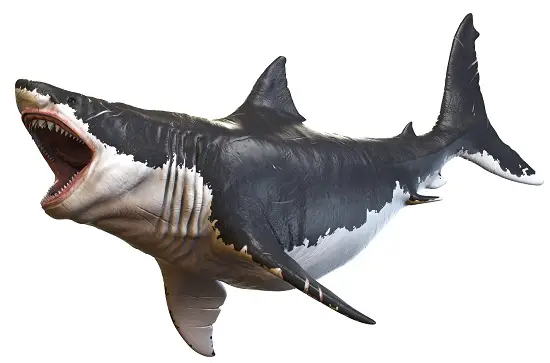
Did megalodon evolve to be smaller
Megalodon is not thought to have evolved to be smaller over time. Megalodon evolved from a smaller ancestor species, Otodus obliquus, which was also a predatory shark.
It is believed that descendants of megalodon evolved over time to become larger and more specialized as a predator and that when conditions changed it went extinct. it is often the case that the first casualties of climate change or environmental change, the likely cause of Megalodons extinction, are Apex predators.
There is plenty of evidence showing shark evolution up to and including megalodon, but nothing that shows it evolved into something more suited for the changing environment.
It is worth noting that evolution does not necessarily lead to larger size, and many species have evolved to be smaller over time in response to changes in their environment or as a result of selective pressures. However, there is currently no evidence to suggest that megalodon evolved to be smaller during its time on Earth.
What is the Closest Relative to Megalodon
Megalodon is classified as a member of the family Otodontidae, which includes a group of extinct predatory sharks. Within this family, the closest relative to megalodon is believed to be Otodus obliquus, which is also known as the ” ancestor shark.” these are also not alive today.
Otodus obliquus lived approximately 45 million years ago and was slightly smaller in size than megalodon, reaching lengths of up to 25 feet or the size of a very large Great White shark.
Otodus obliquus is considered to be the immediate precursor to megalodon, as it is thought to have evolved into the giant shark over time. Otodus obliquus had a similar body shape to megalodon, with a large, conical snout and powerful jaws. It is also believed to have been an apex predator, preying upon a variety of marine animals, including bony fish, marine mammals, and other sharks.
While megalodon and Otodus obliquus are closely related, they are not the only members of the Otodontidae family. Other members of this family include the shark species
- Megaselachus megalodon,
- Megaselachus kapalensis
- Otodus aksuaticus
- Carcharocles chubutensis.
All of these species were large, predatory sharks that lived during different time periods and inhabited different parts of the world. You can learn more about them on the links on their names.
Are Megalodon Documentaries real?
There have been several documentary films and television shows that feature megalodon, However, the accuracy of these documentaries varies widely.
Some megalodon documentaries are based on scientific evidence and provide a relatively accurate portrayal of the giant shark and what is known about its biology, behavior, and extinction.
These documentaries may feature interviews with experts, use computer-generated imagery (CGI) to recreate what megalodon may have looked like, and present information about the shark in a factual and informative manner. A example of this is prehistoric Monsters: we found it on Youtube here.
Other megalodon documentaries, however, are less scientific in nature and may rely on speculation and sensationalized storytelling in order to generate interest, including ones even shown on scientific channels.
These documentaries may present unproven theories about megalodon’s existence or exaggerate certain aspects of the shark in order to create a more dramatic narrative. While entertaining ( and they really are) they are not fact based and some even go as far as falsifying proof to suggest megalodon is alive today. You can read more about this on the fossilguys blog.
He goes into more details on the use of actors, misleading questions and fake images which the documentary makers are alleged to have used in their productions to suggest megalodon is alive. For Example
The “declassified” U-Boat image from 1942 showing a giant fin and tail in the background is fake. This photo was doctored for the show. George Monbiot, a Guardian columnist, found the original footage. It’s a screenshot from an archival U-boat film.
Jayson Kowinsky
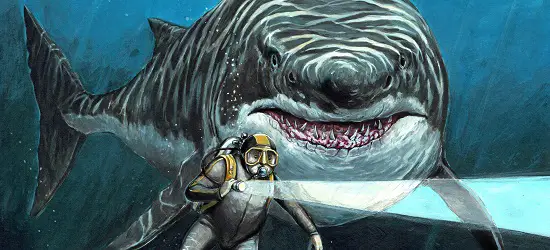
It is important to be critical of the information presented in any documentary and to consider the sources and evidence that are used to support the claims made. Not all megalodon documentaries are created equal, and some megalodon documentaries may be more accurate and reliable than others.
It can be helpful to do your own research and seek out additional information from reputable sources in order to gain a more well-rounded understanding of the subject. It is also important to recognise the difference from what you want to be true, to what is the actual truth. To be clear there in no, zero, nada evidence megalodon is alive today.
Was a Basking Shark bigger than a Megalodon
No, the basking shark (Cetorhinus maximus) is not larger than megalodon. Megalodon is believed to have been the largest shark that has ever lived, reaching lengths of up to 60 feet and weighing as much as 50 tons. In comparison, basking sharks are much smaller, typically reaching lengths of up to 40 feet and weighing up to 20 tons.

While megalodon and basking sharks are both large sharks, megalodon was significantly larger and more formidable than the basking shark. In contrast, basking sharks are filter feeders that do not have the same predatory adaptations as megalodon, thankfully!
With the similar body shape and the similarity in size it is easier to understand why sightings of this shark may have conjured up stories of Megalodon still being alive, and the basking Shark plays an important role in the story of the Megalodon, at least in recent years.
They also can grow to over 40 feet long which is Average or even large Megalodon size and double a large Great white Shark and although being filter feeders like whales, they also do resemble, superficially at least, more attack minded sharks.
When these wash up on shore, or are seen in the ocean it is possible to see where the stories of the monster sharks may have come from. However, although accidental misidentification can be forgiven, it is often then used as evidence of the continuing existence of megalodon and proof that megalodon is alive today.
To be completely clear, the basking shark although being of a similar size to a Megalodon, is certainly not a ramaging shark chewing its way through the whale populations. It is, like the Whale Shark, a gentle giant that lives in cold water, something a Megalodon didn’t and couldn’t do. Which leads us too….
Was a Whale Shark Bigger than a Megalodon
No, the whale shark (Rhincodon typus) is not larger than megalodon. Whale sharks are the largest living fish in the world, but they are significantly smaller than megalodon, typically reaching lengths of up to 50 feet ( the longest being an incredible 61 feet) and weighing up to 9 tons (19,000 lbs) . So close, but no cigar!
Whale sharks are found in warm waters around the world and are known for their filter-feeding behavior, in which they filter large volumes of water through their gills in order to capture plankton, small fish, and other small marine organisms. They are gentle giants that are not aggressive towards humans and are often encountered by divers and snorkelers.
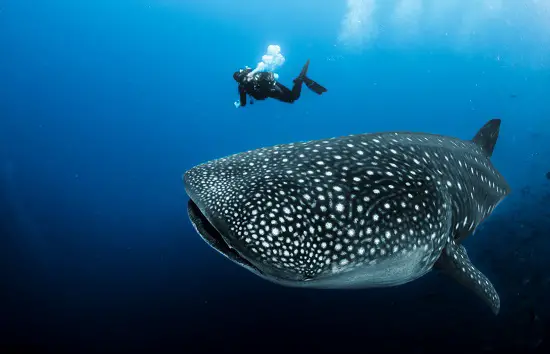
Although bigger than a basking shark, and currently the largest fish in the oceans today the Whale shark looks incredibly different to the predatory Megalodon, although as we know from personal experience, even knowing they pose no danger it can still be a disquieting moment seeing one swimming towards you as we have experienced on two occasions. We have a video of this below.
Could Orcas beat a Megalodon
Orcas, also known as killer whales, are highly intelligent and adaptable predators that are found in all the world’s oceans. They are known for their predatory behaviors, including hunting in groups and using cooperative tactics to catch and kill their prey. Orcas are also very large animals, with males reaching lengths of up to 32 feet and weighing, rarely though, up to 22,000 lbs
It is difficult to say with certainty whether orcas (Orcinus orca) would be able to defeat a megalodon, as megalodon is an extinct species and there is no way to observe their behavior or test their abilities in the modern world.
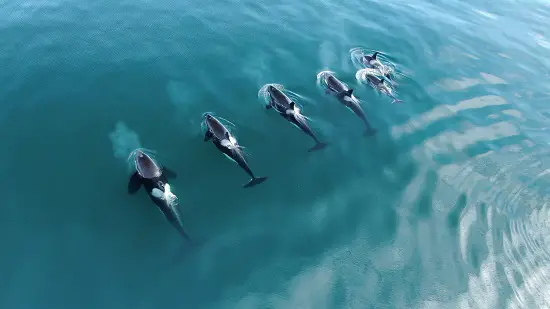
Additionally, the size and strength of a megalodon would make it a formidable opponent, and it is possible that the shark could also pose a threat to orcas.
Given their size, intelligence, and predatory abilities, it is possible that orcas could potentially pose a threat to a megalodon, especially a young megalodon. However, it is important to note that this is speculation, as there is no way to observe the behavior of these animals in the modern world. Remember megalodon is not alive today! ( and not because of Orcas, before you ask!)
Have people even seen a Megalodon.
With Megalodon going extinct between 2-3 million years ago they predate humans, home sapians at least, but about a million years. ( some would say thankfully) before humans. So no human has even seen a living megalodon.

While it is possible that megalodon that if a living Megalodon encountered people it would have potentially attacked humans in the water, it is more likely that the shark would have preferred larger and more easily accessible prey, such as marine mammals or other sharks. We would be both uncommon and a little on the small side for a full size Meg to bother with a juvenile however…..
So movies like the Meg, and the upcoming Meg 2, while most certainly entertaining, are deep in the realms of fiction.
Megalodon Teeth.
While megalodon teeth are found very regularly in places like South east USA and Peru ( which were shallow seas in the time of the megalodon. These are not new teeth and will at their earliest be dated to around 2 to 3 million years old.
There was a little excitement generated when Megalodon teeth discovered in the 1950’s were dated as just 10-24,000 years old. (As mentioned on the fossilguys blog) However the process they used, Magnesium Dioxide dating, has now been deemed incorrect and inaccurate and these teeth were actual million of years old rather than a relatively recent 10,000 years old!
We have an article on the site that offers tips on finding your own megalodon teeth, and other shark teeth if you are heading to a beach near you anytime soon.
Are there Pictures and Photos of Megalodon
Photographs can be changed or added to to suggest that megalodon is alive today, however pictures are, understandably, even less useful evidence. There have been drawings of monster sharks that have washed up on the shores of countries all over the world, but, of course, these are artistic impressions either from eye witness descriptions, or from a shark’s body washed up on the shore. They can not be used as evidence that megalodon is alive today.
There have been examples of these monster sharks that even had been given legs in drawings of the events! The one below for example is a drawing, it is not, let me say that again NOT evidence that megalodons are alive today!

Why did Megalodon go extinct
Megalodon, the giant shark that is believed to have gone extinct over 2 million years ago. It likely went extinct due to a combination of factors.
Scientists believe that megalodon, like many other species, may have gone extinct as a result of environmental changes that occurred during the Late Miocene and Early Pliocene epochs.
During this time period, the Earth’s climate and oceans underwent significant changes that may have affected the ability of megalodon and other large species to survive. For example, sea levels dropped dramatically, oceans cooled and currents changed.
This pushed megalodons prey to cooler waters in search of food, a place megalodon could not follow. it also would have affected their breeding grounds ( thought to be warmer waters)
All of this would have reduced the availability of suitable habitat for megalodon and other large marine animals. Megalodon was not the only large marine animal to extinct around this time. ( google Livyatan or check out our article on a side by side comparison with megalodon)
Other factors that may have contributed to megalodon’s extinction include competition with other predatory species, such as smaller shark species that may have been more adaptable to changing environmental conditions, and changes in the distribution and abundance of prey species.
It is important to note that the exact cause of megalodon’s extinction is still not totally understood, and scientists continue to study this topic in order to better understand the factors that may have contributed to the giant shark’s demise. However, its worth mentioning again, megalodon is not alive today!
We have a selection of articles on Megalodon and other of the large Marine reptiles here on the site you can check them out in the list below.
- What was the bite force of a Megalodon
- Best Megalodon Movies
- Are Megalodon alive today?
- Where to find Megalodon teeth
- Megalodon Vs. Blue Whale
- How Big was Kronosaurus
- How Big was Mosasaurus
Conclusion
The largest shark to ever live megalodon is not alive in today’s oceans. it went extinct around 2-3 million years ago due to a combination of cooling oceans, climate change, reducing and evolution of prey species, and increased competition from other more adaptable ocean predators.
There is no credible evidence put forward that megalodon could have survived these changes, and no fossils earlier than 2-3 million years ago have been found.
References
- https://www.nhm.ac.uk/discover/megalodon–the-truth-about-the-largest-shark-that-ever-lived.html#:~:text=The%20cooling%20of%20the%20planet,a%20significant%20loss%20of%20habitat.
- https://www.haaretz.com/science-and-health/2022-05-31/ty-article/why-did-megalodon-go-extinct-new-study-outs-unexpected-culprit/00000181-18f5-d57f-afc1-b8f7de9e0000
- https://www.britannica.com/story/what-happened-to-the-megalodon
- https://www.nationalgeographic.com/science/article/megalodon-extinct-great-white-shark
- https://www.iflscience.com/could-megalodon-still-live-deep-ocean-24918
Hi, I am Roy Ford a General Studies and English Teacher who has taught all over the world. What started as a fossil collection became a great way to teach, motivate and inspire students of all ages and all over the world about dinosaurs and from that and children’s love of dinosaurs came the site dinosaur facts for kids, a resource for all ages.

